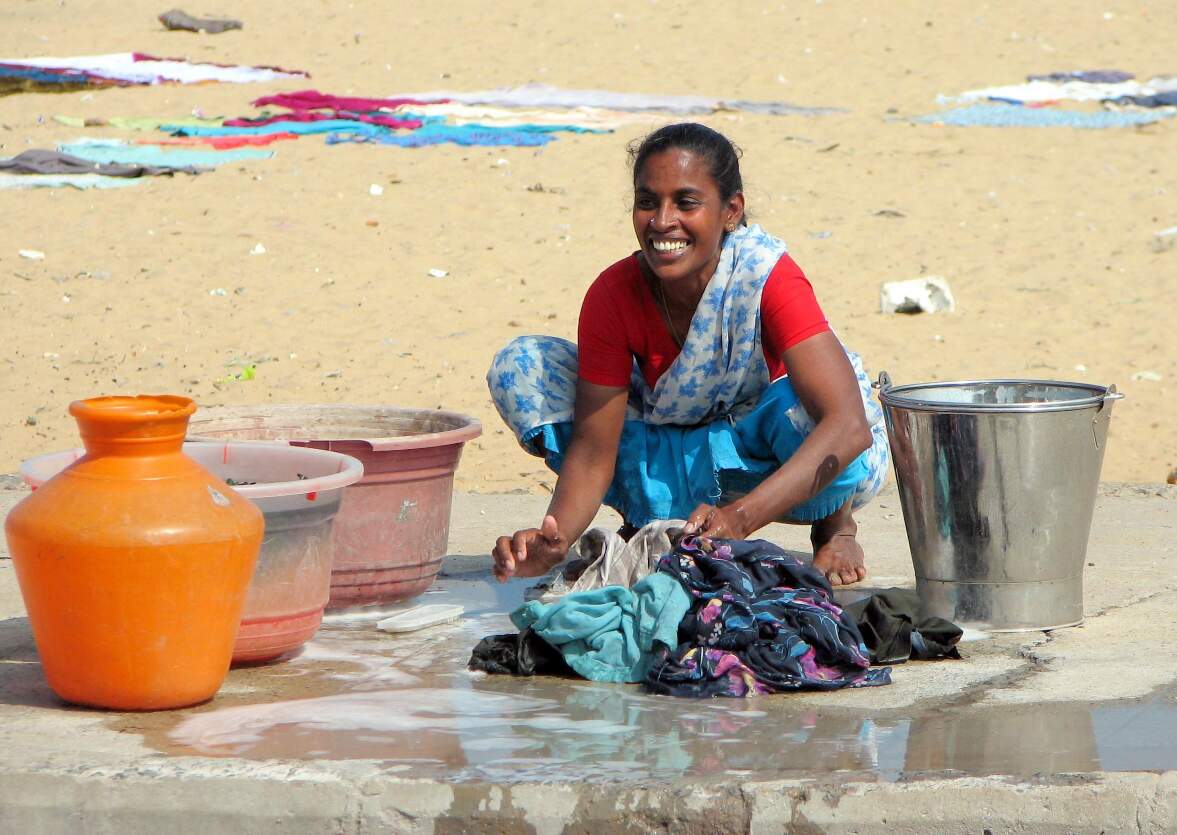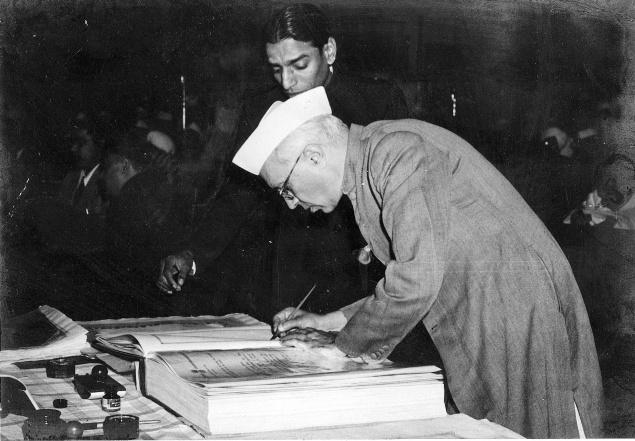Should Homemakers Be Paid for House Work? What Women Freedom Fighters Said in 1940
Among the key recommendations of their report was that a woman should have an absolute control over some part of the family income and a share in the husband's property which he cannot will away.

Last month, Tamil actor-politician Kamal Haasan issued his political party’s seven point governance and economic agenda ahead of the State Assembly elections. One of the points issued by his party, Makkal Needhi Maiam (MNM), was that, “Homemakers will get their due recognition through payment for their work at home, which hitherto has been unrecognised and unmonetized, thus raising the dignity of our womenfolk.”
Image above of Rani Lakshmibai Rajwade (left) and Mridula Sarabhai walking with MK Gandhi (Image courtesy dspace.gipe.ac.in and Nandini K Oza Blog)
In other words, MNM seeks to recognise housework as a salaried profession. This sparked a massive debate on social media with various sides taking positions for and against the idea. While many are discussing the merits of this policy idea today, it isn’t anything new.
For decades, many Indian women have sought recognition of the inherent economic value that lies in house work from both the state and society. Probably the earliest recognition of this need was illustrated in a 1940 report titled ‘Women’s Role in Planned Economy’ (WRPE) prepared by a sub-committee for women under the National Planning Committee (NPC).
The NPC was a body that undertook the process of devising India’s future economic developmental plans as the country marched towards Independence. It was set up by the Indian National Congress in 1938 at the joint initiative of Subhas Chandra Bose and Jawaharlal Nehru.
Although the chairmanship of the NPC was entrusted with Nehru, this particular sub-committee formed in 1939 was chaired by an Indian Independence activist and stalwart feminist, Rani Lakshmibai Rajwade. Working closely alongside her was member secretary, freedom fighter, Gandhian and avowed secularist, Mridula Sarabhai.
She presented the final report of the sub-committee before the plenary session of the NPC in 1940. But it was only seven years later in July 1947 when the WRPE report, along with those of several other sub-committees of the NPC, was sent for official publication under the editorship of KT Shah, a renowned member of the Constituent Assembly and a lawyer.
The two women behind WRPE
Both women were remarkable in their own right.
Lakshmibai Rajwade, a doctor by education, was an influential member of a drafting committee of the All India Women’s Conference (AIWC), chaired by Sarojini Naidu. The AIWC sought universal franchise and opposed affirmative action for women in future elections, in a draft report submitted to the 1931 Second Round Table Conference.
Married to Major General C. R. Rajwade, the erstwhile king of the Gwalior state, she was also one of the earliest and strongest advocates for family planning, which was heavily opposed by certain members of the national movement.
In fact, opposition to her strong views on family planning grew so harsh that Nehru persuaded Rajwade to “approach the subject in a manner which is least offensive to large sections of people”. Suffice it to say, she didn’t quite back down. Post-Independence, in 1950, she became one of three Indian delegates to the United Nations Economic and Social Council.
Meanwhile, Mridula Sarabhai, the sister of nuclear scientist Vikram Sarabhai, was barely 19 when she joined the Congress Seva Dal during Mohandas Karamchand Gandhi’s famous Salt Satyagraha in March 1930. During this time, she organised the boycott of British goods, and was even arrested for her participation in the Salt Satyagraha.
She would go on to play an integral role in the Congress, leading its women’s wing for some period of time. However, she really came into her own, as India began descending into communal violence a year ahead of Independence.
“She joined Gandhi in his Noakhali tour in 1946, when she saw Hindus being butchered by Muslims and later in Bihar, where Hindus reciprocated with double the brutality. She became danger’s daughter, daring sister. In the pre-Partition weeks and months Mridula was where men blinded by lust and bigotry were making women their special targets. She could have been brutalised a hundred times herself and murdered. Leaders in India and Pakistan alike praised her courage [and] her commitment,” writes Gopalkrishna Gandhi, a former diplomat.
Following Independence, she fell out with Nehru and Congress over their Kashmir policy and became one of Sheikh Abdullah’s strongest supporters outside the Valley.

Economic value of housework
There is no denying that the entire burden of domestic house work falls on the shoulders of housewives/homemakers, particularly in middle-class families that cannot afford servants.
Responding to a similar reality back in the late 1930s, the authors of the WRPE noted, “We feel that this work, which at present receives no recognition either from the State or society, should be recognised as having an economic value and that work in the home should not be considered in any way inferior to the other type of work done outside the home.”
They argue that besides activities like cooking and washing, they also play a pivotal role in creating “a cultural environment in the home for the proper nurture of children” and to some extent, fixing “the standard of life”. Unfortunately, these critical roles that homemakers play aren’t realised to their fullest extent, because they are neither trained nor educated for it.
The standard narrative peddled by a plethora of communities across India is that the man is the “bread-winner”, and thus considered much more important than a homemaker, who “just ends up spending what he brings home”. But what these narratives fail to take into account is the homemaker’s indirect contribution to the family income through her labour.
Without her labour, can the male ‘breadwinner’ function to his highest capabilities? Authors of the WRPE argue that a lack of recognition for this work and a homemaker’s constant dependence on the man for everything she wants reduces her to a slave. “This social degradation has brought into contempt the work of the woman in the home,” they note.
Therefore, the report arrives at a conclusion that “unless the home worker is considered as much a productive worker as the one who is engaged in work outside home, and is given the annas in the same way that the work of those enjoyed by workers in, say, industrial labour, it will be difficult to raise the dignity of labour in home.”
Unlike the suggestion of actor-politician Kamal Hassan for the provision of a monthly salary to homemakers, the authors of WRPE believe that a woman’s work in home cannot be translated into actual rupees the same way as industrial workers. However, the authors do believe that there are other ways and means of recognising this work.
The report recommends three things:
1) Woman should have an absolute control over some part of the family income;
2) Woman should have a share in the husband’s property, which he cannot will away; and
3) The husband should give his wife’s share of the contribution to any social insurance scheme that may be introduced by the State.
They also argued that while it’s difficult to fix work hours for homemakers, it’s imperative they have some time to themselves for their “self-improvement”.
For this provision, they have two more recommendations:
1) Labour saving devices may be introduced in the home, which will relieve her of the drudgery of her work; and
2) Creches should be established by the State where she can leave her child or children whenever she wishes to be free.
The report goes on to argue that the “home will not be considered to be an exclusive sphere of women’s work.” In cases where both women and men are wage earners, they recommend that both will equally contribute to household expenses and share actual duties of cooking, cleaning, etc. As stated earlier about the lack of training in domestic science, the report recommends that men and women should train in it and that facilities for the same should be made available.
“Man will learn to look upon home-work as something not below his dignity. This will save the man from his present helpless position when the wife is ill or away from home,” it adds.
What does the report mean?
According to noted scholar Nirmala Banerjee’s 1998 article published in the Economic and Political Weekly (EPW) publication, “The report of the WRPE is worth our notice if only because of its historical relevance; it shows that, even then, Indian women were by no means the icons awaiting male hand-outs as has been visualised by several scholars.”
She goes onto note, “The WRPE [also] deserves credit for recognising right at the outset that economic rights for women were contingent on each woman being treated as a separate unit in the economic structure.”
Titled Whatever Happened to the Dreams of Modernity? The Nehruvian Era and Woman’s Position, the article talks about how some of the more radical recommendations by the WRPE report got lost in the larger arc of the freedom struggle. This particular recommendation on women’s unpaid labour in the family’s economic activities and in the household lost steam at the 1940 plenary. The report was itself forgotten by history until another scholar of note, Maitreyi Krishnaraj, in 1995 resurrected it from archival sources.
Both Banerjee and Krishnaraj argue that the reason why some of the more progressive recommendations lost steam was because these women were “trying to make a very aggressive and unfamiliar individuality for women acceptable in a society which was totally unfamiliar with the idea”.
What probably came in the way was “the task of forging a new national identity out of the struggles emerging from a hated colonial rule.” To forge that new identity, there was a need to “glorify its own past traditions” and therefore there was no room for such an idea.
Banerjee also blames Nehru for failing to step up to the plate in implementing these recommendations both as chairman of the NPC and later the Planning Commission.

“The views expressed by the WRPE in 1939 were not the wild dreams of an individual, but a reflection of the ideas that were in circulation at that time among the politically conscious, and specially among those who had been familiar with international events. The complete disappearance from 1951 onwards of that past in the new planning team, including Nehru himself, suggests more a deliberate reversal of policy positions,” she notes.
Nonetheless, these ideas are making a comeback now. Hopefully, this time, the larger public discourse can no longer ignore an idea whose time has probably come.
(Edited by Divya Sethu)
Like this story? Or have something to share? Write to us: [email protected], or connect with us on Facebook and Twitter.

Similar Story

Netaji Bose’s Favourite Eatery Has Been Serving Traditional Delicacies for Over 100 Years
The Swadhin Bharat Hindu Hotel in Kolkata, started by Mangobindo Panda, is a century-old pice hotel where Indian freedom fighters like Netaji Subhas Chandra Bose would enjoy Bengali delicacies.
Read more >
If you found our stories insightful, informative, or even just enjoyable, we invite you to consider making a voluntary payment to support the work we do at The Better India. Your contribution helps us continue producing quality content that educates, inspires, and drives positive change.
Choose one of the payment options below for your contribution-
By paying for the stories you value, you directly contribute to sustaining our efforts focused on making a difference in the world. Together, let's ensure that impactful stories continue to be told and shared, enriching lives and communities alike.
Thank you for your support. Here are some frequently asked questions you might find helpful to know why you are contributing?


This story made me
-
97
-
121
-
89
-
167












